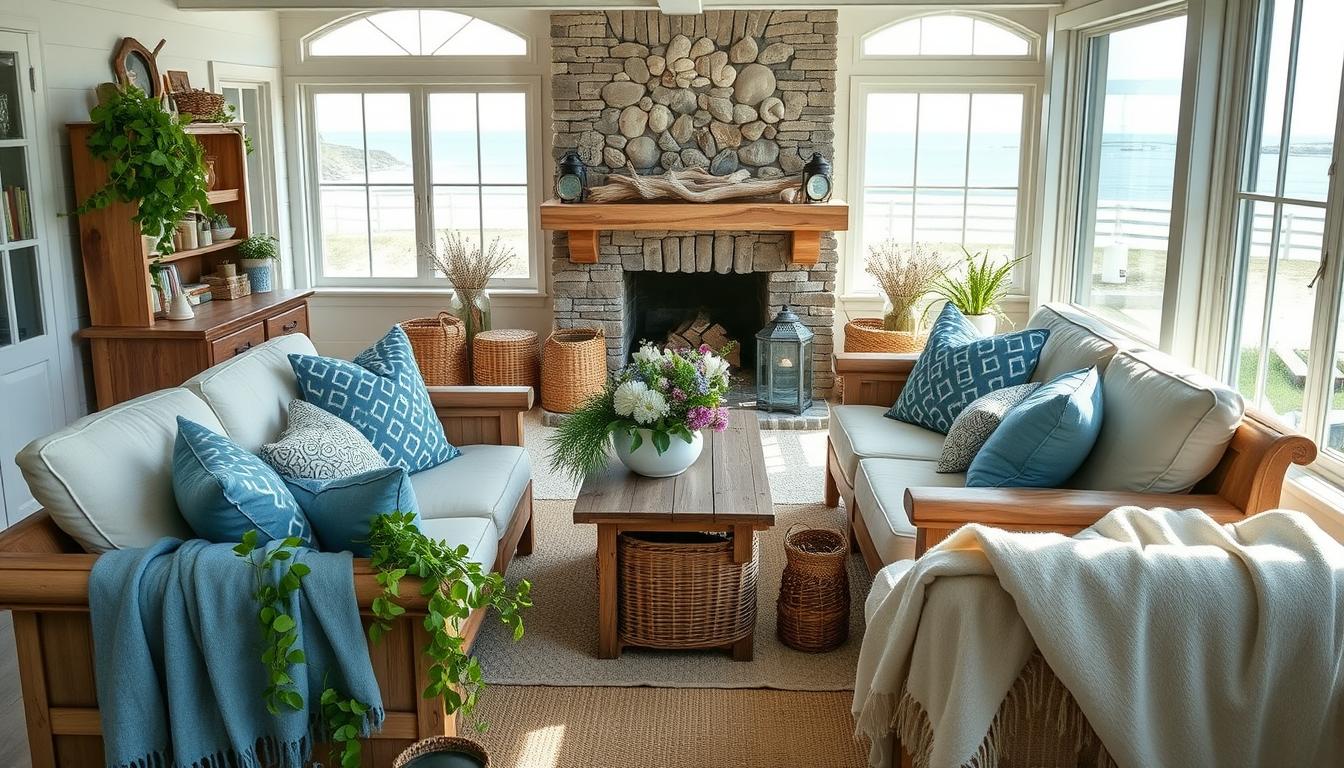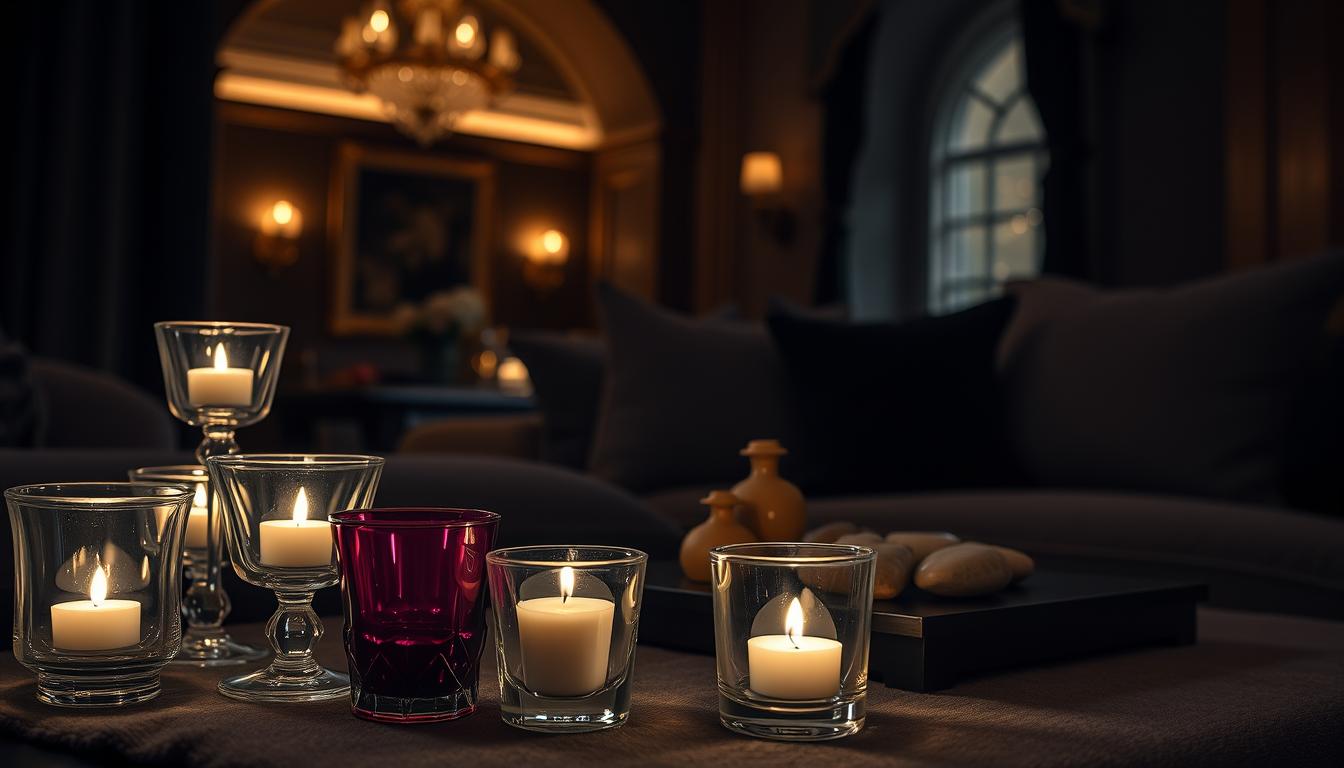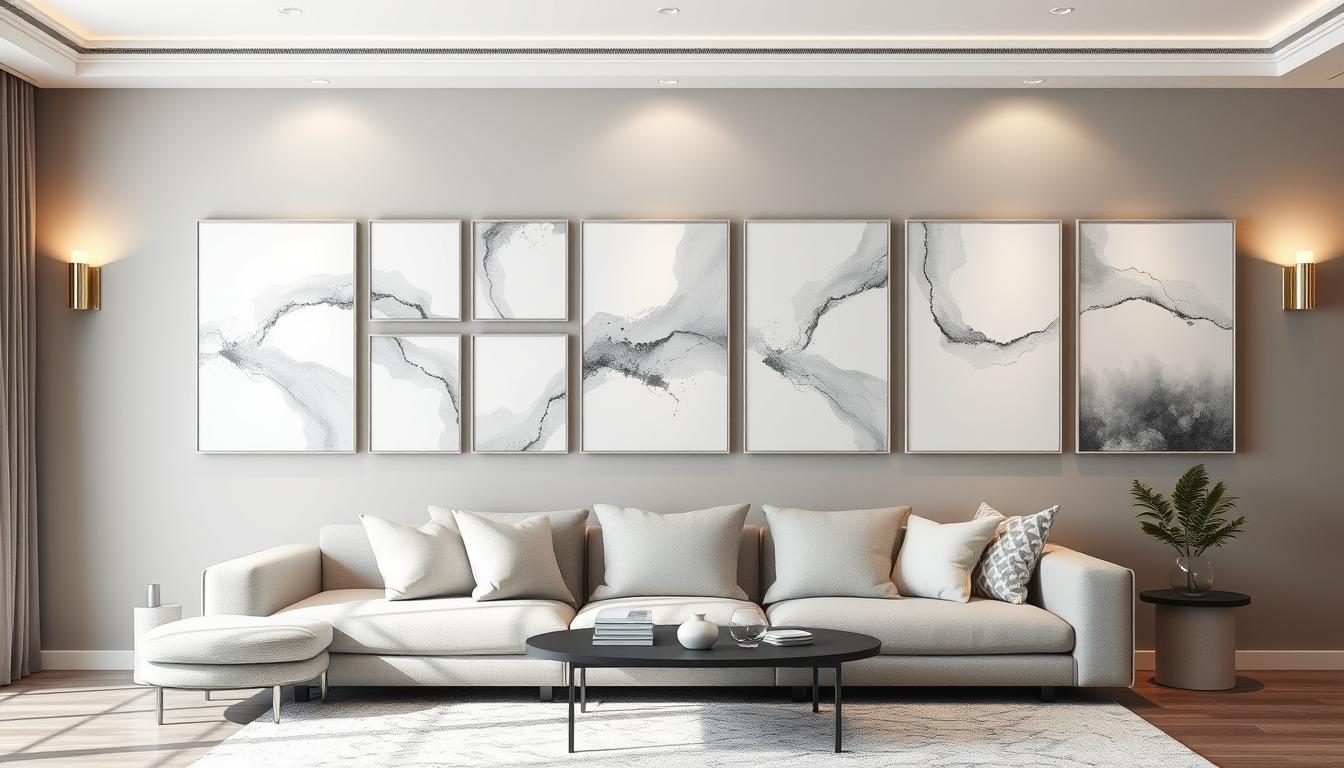Did you know the coastal farmhouse style is getting more popular? Many people want to bring the beachy feel into their homes. This style mixes the cozy feel of a farmhouse with the coolness of a coastal area.
We’ll show you how to get this look in your coastal farmhouse home interior. Our guide will cover important steps, like picking the right colors and materials. You can see more tips in our guide on country-style homes interior.
By the end of this guide, you’ll know how to make a beautiful and welcoming space. It will show off your personal style.
Key Takeaways
- Understand the key elements of coastal farmhouse style
- Learn how to choose the right color palette for your space
- Discover how to select materials that inspire a coastal feel
- Get tips on incorporating natural textures and elements
- Find out how to balance coastal and farmhouse elements
Understanding the Coastal Farmhouse Aesthetic
The coastal farmhouse style mixes rustic charm with coastal freshness. It’s all about warmth and coziness, yet light and airy. This blend creates a welcoming space.
To understand coastal farmhouse, we must explore its core elements. We’ll look at what makes this style unique.
What is Coastal Farmhouse Design?
Coastal farmhouse design combines farmhouse warmth with coastal elegance. It uses natural materials, soft colors, and vintage and modern pieces. This mix creates a unique look.
Key characteristics include natural textures, soft colors, and coastal or farmhouse themes. These elements make the style stand out.
Key Elements of the Style
The coastal farmhouse style has several key elements. These elements work together to create its distinctive look. Let’s look at these elements:
- Natural materials like reclaimed wood, stone, and brick
- A neutral color palette with soft, calming hues
- Comfortable, inviting furniture with a mix of vintage and modern pieces
- Decorative elements that reflect coastal or farmhouse themes
Now, let’s see how these elements come together in a cohesive design theme:
| Element | Description | Example |
|---|---|---|
| Natural Materials | Use of reclaimed wood, stone, and brick to add warmth and texture | Reclaimed wood beams in a living room |
| Neutral Color Palette | Soft, calming colors that evoke a sense of serenity | Soft blue walls with white trim |
| Comfortable Furniture | A mix of vintage and modern pieces that create a cozy, inviting atmosphere | A vintage armchair paired with a modern sofa |
Influences of Coastal Living
Coastal living greatly influences the coastal farmhouse aesthetic. It brings lightness and airiness to the design. This is done with light colors, natural textures, and bringing the outdoors in.
By adding coastal living elements, we can make a coastal farmhouse interior feel welcoming and serene.
Choosing the Right Color Palette
The right color palette is key for coastal farmhouse style. It mixes the calm of the sea with rustic charm. A good color scheme sets the mood for your home, affecting the feel of each room.
Soothing Coastal Hues
Coastal farmhouse interiors often use soft blues, pale greens, and creamy whites. These colors remind us of sea foam, driftwood, and misty mornings by the ocean. Soft blues bring a calming feel, like a clear sky or calm waters.
Farmhouse Neutrals
Farmhouse neutrals add warmth and invite you in, contrasting with cool coastal hues. Beige, taupe, and weathered wood tones are common in coastal farmhouse design. These neutrals make your home cozy and welcoming. Weathered wood tones add rustic charm to furniture and decor.
Accent Colors for Impact
Accent colors add depth and personality to your space. Think about using corals, yellows, or deep blues as accent colors. Use them in accessories, artwork, or statement furniture to make your coastal farmhouse home unique.
By mixing soothing coastal hues, farmhouse neutrals, and accent colors, you create a welcoming color palette. This mix captures the beauty of the coast and the simplicity of farmhouse living.
Selecting Materials that Inspire
To capture the essence of a coastal farmhouse, focus on materials that inspire warmth and coziness. The materials you choose are key in defining the coastal farmhouse home interior. They blend the rustic charm of a farmhouse with the freshness of coastal living.
Natural Wood Finishes
Natural wood finishes are a must in rustic home design. They add warmth and character to any room. Reclaimed or distressed wood adds a sense of history and authenticity.
Whether for flooring, furniture, or wall paneling, natural wood finishes bring a cozy, organic feel. This makes your space feel welcoming and unique.
Textiles and Fabrics
The right textiles and fabrics can greatly impact your interior decorating. They add texture and depth to your coastal farmhouse home. Opt for natural fibers like cotton, linen, or jute for upholstery, curtains, or rugs.
These materials not only enhance the aesthetic but also make your space cozy and inviting. They help create a warm and welcoming atmosphere.
Eco-Friendly Options
Choosing eco-friendly options for your coastal farmhouse design is good for the environment. It also adds authenticity to your home. Consider using recycled materials, sustainable wood sources, or low-VOC paints.
These choices align with the natural, effortless vibe of the coastal farmhouse style. They make your home both beautiful and sustainable.
By carefully selecting materials that inspire and connect with nature, you can create a coastal farmhouse home interior that is stunning and eco-friendly.
Furniture Essentials for Coastal Farmhouse Interiors
Choosing the right furniture is key to a coastal farmhouse interior that feels warm and full of character. This style mixes the fresh feel of coastal living with the rustic charm of a farmhouse. The furniture you pick is crucial for this balance.
Identifying the Right Styles
Coastal farmhouse furniture should blend modern comfort with vintage or rustic touches. Look for pieces with clean lines, little ornamentation, and natural materials like wood or wicker. This creates a cozy, stylish space.
Popular styles for coastal farmhouse include:
- Reclaimed wood furniture adds history and character.
- Wicker or rattan brings a natural, organic feel.
- Slipcovered sofas and chairs offer casual comfort.
Functionality vs. Aesthetics
Designing a coastal farmhouse interior means balancing looks with function. Your furniture should be beautiful but also practical. For instance, a stylish storage ottoman can hold throws and books while doubling as seating.
To find this balance, consider these tips:
- Choose pieces that do more than one thing.
- Go for furniture with simple shapes that won’t clutter.
- Add color and texture with throw blankets and pillows.
Incorporating Vintage Pieces
Vintage or antique furniture adds a special touch to your coastal farmhouse decor. It brings character and depth. When adding vintage items, think about the look you want and pick pieces that fit.
Here are some tips for vintage furniture:
- Begin with one or two standout pieces and build around them.
- Combine vintage with newer items for a layered look.
- Feel free to refinish or repurpose vintage furniture to match your style.
Lighting that Complements the Aesthetic
In coastal farmhouse design, lighting is key. It sets the mood for your home. Good lighting makes your space look beautiful and welcoming.
Types of Lighting Fixtures
Using different lighting fixtures is important. This creates a layered lighting effect. You’ll need:
- Ambient lighting: This lights up the whole space.
- Task lighting: It focuses on areas for tasks like reading or cooking.
- Accent lighting: It highlights special features or decorations.
For a coastal farmhouse look, choose fixtures from natural materials. For example, a wooden chandelier can warm up your dining area.
| Lighting Fixture | Description | Ideal Use |
|---|---|---|
| Pendant Lights | Hang from the ceiling, often used over kitchen islands or dining tables. | Task lighting, ambient lighting |
| Table Lamps | Placed on tables or shelves, available in various styles and materials. | Task lighting, accent lighting |
| Chandeliers | Ceiling-mounted, often decorative and statement-making. | Ambient lighting, accent lighting |
Using Natural Light Effectively
Maximizing natural light is key in coastal farmhouse interiors. Large windows and skylights make your home brighter and airier. Here are some tips:
- Keep windows clear of heavy curtains or furniture.
- Use sheer curtains or blinds to control the light.
- Place mirrors opposite windows to reflect light into the room.
“The way to get started is to quit talking and begin doing.” – Walt Disney. This quote fits well with lighting in our homes. It’s about making a space that feels alive and inviting.
Creating Warm Ambiance
To create a warm feel in your coastal farmhouse, layer your lighting. Mix overhead lights, table lamps, and candles for a cozy vibe. Dimmer switches help adjust the light for different moods and times.
By carefully choosing and layering your lighting, you can make your cozy farmhouse living better. And you’ll stay current with the latest home decor trends in interior decorating.
Decorative Touches that Make a Difference
Decorative touches make a coastal farmhouse interior come alive. They make it feel welcoming and personal. These elements show your personality and improve your home’s look.
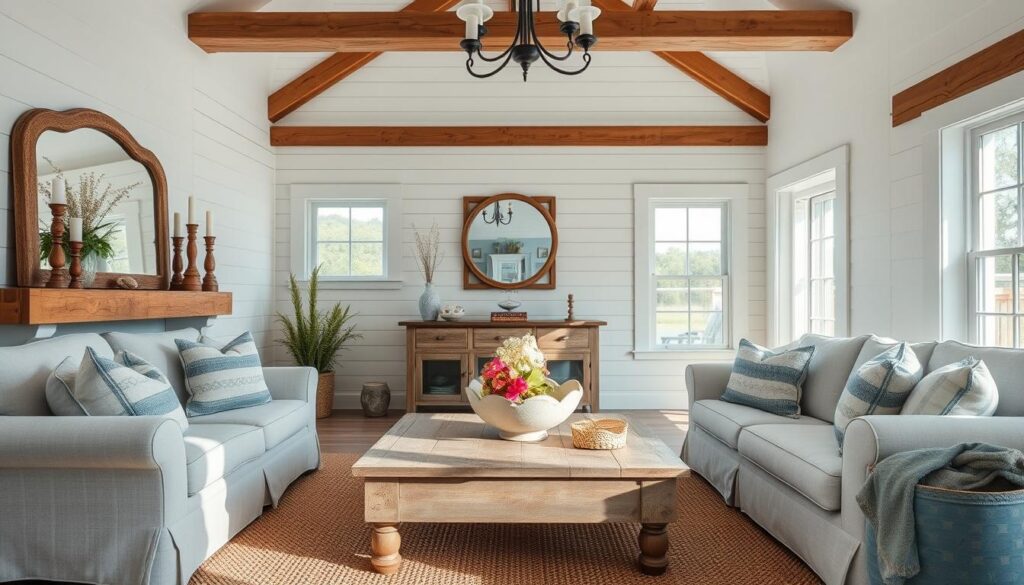
Artwork and Wall Decor
Artwork and wall decor add a personal touch to your coastal farmhouse. Choose pieces that show the coast’s serene beauty, like seascapes or botanical prints. Family photos or vintage maps can also add warmth and history.
Think about the frame style too. Rustic wooden frames or whitewashed frames fit the coastal farmhouse style well. They help set the mood of the room.
Accessories for Coastal Charm
Accessories are key to coastal charm in your farmhouse. Look for items that remind you of the sea or simple country life, like shells, driftwood, or vintage nautical instruments. Display them on shelves, mantles, or side tables for interest.
Textiles are also important. Use natural fibers like jute, linen, or cotton in throw blankets, pillows, and rugs. They make your space cozy and organic.
Plants and Greenery
Plants and greenery improve air quality and add nature indoors. They’re key to the coastal farmhouse look. Pick plants that do well indoors and look natural, like potted greenery or hanging plants.
Don’t forget the containers. Teracotta pots or woven baskets add rustic charm. Grouping plants creates a lush, welcoming feel that connects to the outdoors.
Flooring Choices for Coastal Farmhouse Appeal
Choosing the right flooring is key to capturing coastal farmhouse charm. The right flooring can make your home feel welcoming and authentic. We’ll look at the top flooring options for a perfect coastal farmhouse look.
Popular Flooring Options
Several flooring options are popular for coastal farmhouse homes. Hardwood flooring adds warmth and character. It comes in many finishes, from rustic to modern, to match your style.
Porcelain or ceramic tile is also great. It’s durable and versatile. These tiles can look like natural stone or wood, offering style without the high cost.
| Flooring Type | Durability | Style Versatility |
|---|---|---|
| Hardwood | High | High |
| Porcelain/Ceramic Tile | High | High |
| Laminate | Medium | Medium |
Combining Style with Durability
Choosing flooring for a coastal farmhouse is a challenge. You need style and durability. Reclaimed wood is a stylish, durable option that tells a story.
In wet areas like kitchens and bathrooms, water-resistant flooring is best. Luxury vinyl tiles (LVT) or porcelain tile are great. They resist spills and humidity without losing style.
“The right flooring can transform a house into a home, making it feel cozy and inviting.” – Interior Design Expert
Maintaining a Cozy Atmosphere
To keep your coastal farmhouse cozy, think about flooring color and texture. Warm-toned hardwood or soft, textured carpets add warmth and comfort.
Area rugs are also important. They help define spaces and add warmth underfoot. Place rugs in key areas to enhance coziness.
Outdoor Spaces and Their Connection to Interior Design
Coastal farmhouse design is all about blending indoor and outdoor spaces. This creates a welcoming and larger living area that celebrates nature’s beauty.
Seamless Transitions from Indoors to Outdoors
Use the same flooring inside and outside to make a smooth transition. For example, hardwood floors on the patio or stone pavers that match your indoor floors can help.
Large sliding glass doors or bi-fold doors are great for joining indoor and outdoor spaces. They offer a clear view and easy movement between areas.
“The way we experience our outdoor spaces has changed dramatically. We’re no longer just stepping outside; we’re extending our living areas.” –
Choosing Outdoor Furniture
Outdoor furniture should be tough, weather-resistant, comfy, and good-looking. Match the style of your indoor furniture to keep a consistent look outside.
| Furniture Type | Material | Style |
|---|---|---|
| Sofa | Wicker/Rattan | Coastal |
| Dining Table | Recycled Wood | Farmhouse |
| Armchair | Weather-resistant Fabric | Modern Coastal |
Incorporating Landscaping Elements
Landscaping is key to linking indoor and outdoor spaces. Adding plants, trees, and flowers makes the transition look great.
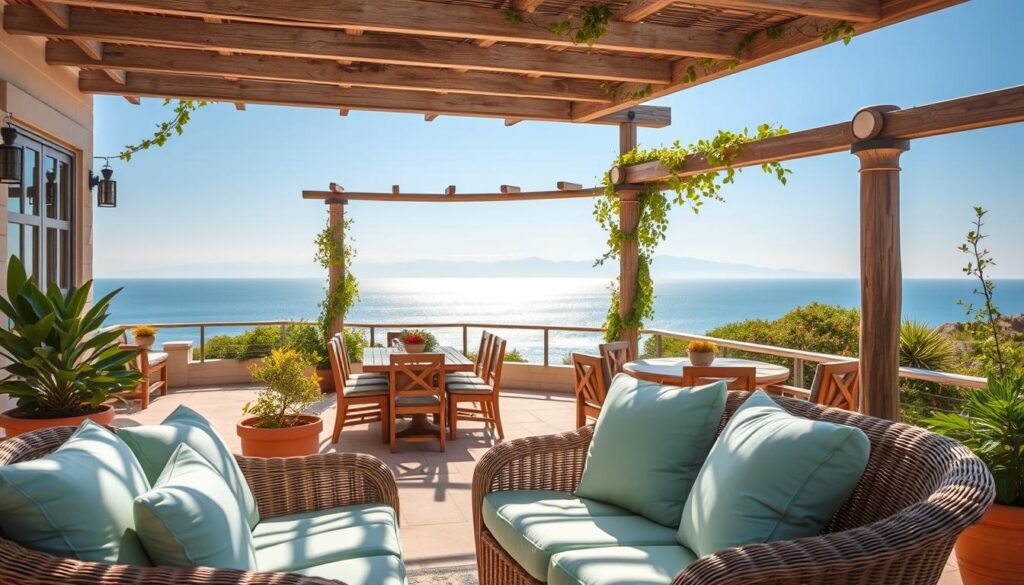
Choose native plants for your area. They need less care and add a real touch to your coastal farmhouse design.
Designing our outdoor spaces well and linking them to our interiors makes our homes more welcoming. It captures the essence of coastal farmhouse living.
Tips for Personalizing Your Coastal Farmhouse Home
Making your coastal farmhouse home your own is key. Add elements that show your style and history. This way, your space will be both stunning and full of meaning.
Making Your Space Unique
To make your home stand out, add personal touches. Use family photos, heirlooms, or collectibles in your decor. Mix rustic and modern elements for a unique look.
Incorporating Family Heirlooms
Adding family heirlooms brings depth and character to your home. Choose items that match your style and enhance your farmhouse decor.
Creating a Cohesive Design Theme
To have a unified look, pick a main element like a color or texture. Use it everywhere. This ties your design together, showing off current trends.

